|
|
|
Sort Order |
|
|
|
Items / Page
|
|
|
|
|
|
|
| Srl | Item |
| 1 |
ID:
158218
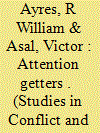

|
|
|
|
|
| Summary/Abstract |
Why do some ethno-political organizations get support from their diaspora while others do not? There is little analysis that examines why some organizations (both violent and nonviolent) get support. Using data on 112 organizations in the Middle East we examine how factors like the power of the organization, ideology, political behavior, and government treatment might impact the likelihood of an organization getting support from its diaspora. We argue that contentious political behavior should have the largest impact on such support. We find that those that do the best job of getting attention through visible action get the most support.
|
|
|
|
|
|
|
|
|
|
|
|
|
|
|
|
| 2 |
ID:
158225


|
|
|
|
|
| Summary/Abstract |
Closed-circuit television footage can be used to assemble an often-complex picture of an incident and aid in the identification of suspects after a crime or terrorist attack has occurred. For example, such footage allowed the police to not only identify the 7/7 London bombers but also to piece together the details of the bombers' movements prior to the attack. In the case of the London bombers little attempt was made to disguise their identities but where such identities are concealed it is possible to identify suspects based on other unique biometric characteristics such as the style of walk, referred to as gait. Gait feature–based individual identification has received increased attention from biometrics researchers. In this article, we propose a novel gait biometric methodology that could contribute to the counterterrorism effort and the identification of individuals involved in crime.
|
|
|
|
|
|
|
|
|
|
|
|
|
|
|
|
| 3 |
ID:
158219
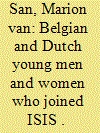

|
|
|
|
|
| Summary/Abstract |
Since the end of 2012 a sizeable number of Belgian and Dutch young men and women have joined the armed conflict in Syria. According to recent estimates, there are 632 Belgian and 260 Dutch foreign fighters in Syria. Very little is known about the families these men and women come from. The research on which this article is based comprised ethnographic research among 26 families with at least one member who has left for Syria to join the armed struggle. In addition, former teachers of these youngsters were asked to reflect on their students' actions. The central question of this article is whether or not the families of youngsters who left for Syria played a supporting role in the departure decision and, therefore, the process of radicalization of the young men and women. To answer this question the families' perception of the armed struggle is described. Also discussed are signals of radicalization present prior to the youngsters' departure and actions taken by the families to prevent departure or alternatively facilitate their trip.
|
|
|
|
|
|
|
|
|
|
|
|
|
|
|
|
| 4 |
ID:
158224


|
|
|
|
|
| Summary/Abstract |
While the threat from terrorism has gained widespread acknowledgment over the last decade, the infiltration of organizations by “terrorist” insiders has not, and the potential dangers these individuals present has not been fully explored. There is a need to understand the wider aspects of insider threats, including motivations and attack methodologies, and to be able to demonstrate the potential devastation that could be caused. Organizations can attempt to mitigate the potential for insider infiltration by both terrorist and other hostile actors, and if such individuals were within an organization, there are procedures and strategies that can be employed to prevent exploitation of existing organizational vulnerabilities and detection of insiders. This article provides an informed and new approach to the connection between insider threat and terrorism.
|
|
|
|
|
|
|
|
|
|
|
|
|
|
|
|
| 5 |
ID:
158226
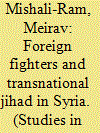

|
|
|
|
|
| Summary/Abstract |
Foreign fighters arrive in Syria from across the Muslim world, yet the configuration of their countries of origin remains a puzzle. Examining alternative explanations for joining transnational jihad, the article draws insights from the cases of Tunisia and Saudi Arabia, two major countries of foreign fighters' origin, compared with Egypt, from where limited figures of volunteers have joined the Syrian war. The article shows that the sources of volunteering fighters may be well understood in combined terms of religious sentiments and national politics. Foreign fighters come largely from Muslim countries where restrained state–Islamists relations channel Islamic grievances to transnational arenas.
|
|
|
|
|
|
|
|
|
|
|
|
|
|
|
|
| 6 |
ID:
158223


|
|
|
|
|
| Summary/Abstract |
The problem of cyberterrorism, despite its contested nature, is an important area of research. Scholars agree that the most dangerous targets for such attacks are critical infrastructure and organizations that are vital to society due to their interconnectedness to the modern world and their increasing reliance on the cyber domain for their operations. Thus, their security and protection against cyberterrorism is of elevated importance. Given the lack of documented cases of cyberterrorism, the purpose of this article is to simulate the threat of a terrorist act on a critical infrastructure, using a computer virus and to investigate how the individual behavior of employees affects security.
|
|
|
|
|
|
|
|
|
|
|
|
|
|
|
|
| 7 |
ID:
158227
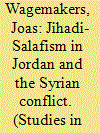

|
|
|
|
|
| Summary/Abstract |
Over the last decade, a rift has emerged among Jihadi-salafis in Jordan between the “Zarqawiyyun”—who see Abu Mus‘ab al-Zarqawi as their model and concentrate on combat—and the “Maqdisiyyun”—who want more scholarly guidance, emphasize the establishment of an Islamic State and follow Abu Muhammad al-Maqdisi. The conflict in Syria, however, offered options for both: a jihad against a reviled regime and the possibility to set up an Islamic state. It thus had the potential to unite the “Zarqawiyyun” and the “Maqdisiyyun.” This article analyzes why this did not happen.
|
|
|
|
|
|
|
|
|
|
|
|
|
|
|
|
| 8 |
ID:
158222
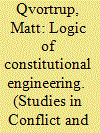

|
|
|
|
|
| Summary/Abstract |
Originally conceived by Aristotle and Thomas Hobbes, comparative constitutional engineering in its modern form is a relatively new field of political science. It is based on the premise that political behavior and policy outcomes can be affected and shaped by institutional design such as, above all, electoral systems. The article provides an overview of the empirical literature underlying this branch of institutional counterterrorism. The article presents the logic of constitutional engineering from its classical origins and especially through the work of Arend Lijphart. It is suggested that Lijphart provides a new paradigm in the sense employed by Thomas Kuhn. The article provides original research in support of this showing that the presence of consensus institutions has better explanatory value than most social factors.
|
|
|
|
|
|
|
|
|
|
|
|
|
|
|
|
| 9 |
ID:
158217
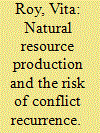

|
|
|
|
|
| Summary/Abstract |
Do different types of natural resources have varying impacts on the risk of conflict recurrence? Using a classification of high-value natural resources according to their lootability and obstructability, this article develops a framework bridging research on natural resources and conflict recurrence. I find evidence for the destabilizing character of easily lootable resources that is coherent across different conflict data. Non-lootable resources show little robust effects at first sight; but when introducing a measure of obstructability, the analysis uncovers varying effects of obstructable and non-obstructable resources that interact with the mode of conflict termination. Overall, the results underline the importance of attending to the lootability and obstructability dimension of natural resources when researching post-conflict risks in resource endowed states.
|
|
|
|
|
|
|
|
|
|
|
|
|
|
|
|
| 10 |
ID:
158221
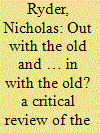

|
|
|
|
|
| Summary/Abstract |
The aim of this article is to critically consider the effectiveness of the “Financial War on Terrorism” on the funding streams of the Islamic State of Iraq and Levant (ISIL). The article begins by identifying that the origins of the “Financial War on Terrorism” can be found in the international efforts to tackle money laundering. It then moves on to consider if the “Financial War on Terrorism” is able to tackle the funding streams of ISIL. The article concludes that the “Financial War on Terrorism” is no longer fit for the purpose to tackle the funding streams of ISIL.
|
|
|
|
|
|
|
|
|
|
|
|
|
|
|
|
| 11 |
ID:
158228
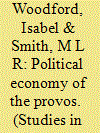

|
|
|
|
|
| Summary/Abstract |
Few academically rigorous accounts exist of the financial activities that sustained the rise of the Provisional Irish Republican Army (PIRA) during the Northern Ireland Troubles. Through a sustained methodology this study seeks to challenge some popular preconceptions and address omissions in the limited historical record. The article explores the organization's evolving financial sophistication by analyzing PIRA's acquisition of capital rather than its arms dealings. Using a new quantitative evaluation, this investigation confronts the prevailing understanding that Irish-American funds were of unrivaled significance to PIRA. It points to an array of domestic fund-raisers that collectively provided the overwhelming bulk of revenue. The study reveals also how PIRA developed an extensive reliance on criminal gangs for its expertise in illegal fund-raising, suggesting that moneymaking schemes were perceived as a necessary but unpopular by-product of the greater political objective. Finally, this article briefly explores how the British authorities sought to interdict PIRA's funding. While the general perception is that little was done to counteract PIRA's financing initiatives in the early phases of its violent campaign, this study, nevertheless, reveals that a subtle counterfinance initiative did take place in Belfast across the 1970s. Overall, the analysis enables a more rounded comprehension of the group's financial resilience.
|
|
|
|
|
|
|
|
|
|
|
|
|
|
|
|
| 12 |
ID:
158229


|
|
|
|
|
| Summary/Abstract |
How does terrorism affect land control in intrastate conflicts? This article explores this question in the case of the Israeli–Palestinian conflict during the Second Intifada (2000–2005), and shows that Palestinian attacks led to an expansion of Israeli outposts in the disputed territories of the West Bank. Following suicide attacks, there is an increase in outposts in home districts of the perpetrators. The number of outposts also increases following deadly attacks against Israelis in West Bank districts where these attacks take place. These results suggest that Israeli settlers use outpost expansion as retaliation against Palestinian communities they perceive to be involved in violence, and this shifts territorial control against Palestinians.
|
|
|
|
|
|
|
|
|
|
|
|
|
|
|
|
| 13 |
ID:
158220
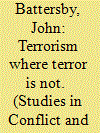

|
|
|
|
|
| Summary/Abstract |
Despite many commonalities in national security priorities, Australia and New Zealand approach the threat of terrorism quite differently. Both had twentieth-century manifestations of domestic terrorism which were generally downplayed. The emergence of jihadist-inspired threats globally have affected Australia much more than New Zealand, and Australian counterterrorism strategy has developed significantly since 9/11. New Zealand has watched global events so far untouched by any jihadist threat, and has implemented few effective counterterrorism measures. The reasons for the differing experience, it is contended here, are the varying historical perceptions of threat, and consequent differing approaches each country has taken to mitigate perceived threat.
|
|
|
|
|
|
|
|
|
|
|
|
|
|
|
|
|
|
|
|
|